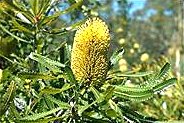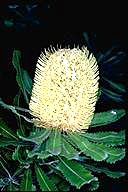| There are 76
Banksia
species,
and all but one occur naturally only in Australia. Banksias were named
after Sir Joseph Banks (1743-1820 ), who, in 1770, was the first European
to collect specimens of these plants. A number of
Banksia cultivars
have also been developed.
Where do they Occur?
South western Australia contains
the greatest diversity of banksias, with 60 species recorded. They are
also an important part of the flora of Australia's eastern coast. Few banksias
are found in the arid regions of Australia or in the rainforests of the
eastern coast.
There are no species which are common
to eastern and western Australia except Tropical Banksia, Banksia dentata,
which occurs across northern Australia, in Papua New Guinea, Irian Jaya
and the Aru Islands.
Banksia Flowers and Fruits
The flower heads are made up of
hundreds (sometimes thousands) of tiny individual flowers grouped together.
The color of the flower heads usually ranges from yellow to red. Many species
flower over autumn and winter.
The fruits of banksias (called follicles)
are hard and woody and are often grouped together to resemble cones (which
they are not true cones are produced only by conifers).
The fruits protect the seeds from
foraging animals and from fire. In many species the fruits will not open
until they have been burnt or completely dried out. The
flowers which, which make long-lasting indoor decorations when dried, are
rich in nectar and are attractive to honey-eating birds. Remove
dead flowers, and tip prune to promote bushiness.
Growing
Banksias from Seed
Banksias are easily propagated from
seed. A common way to release seed is to place the 'cone' in an oven at
120°140° C for about an hour. The follicles then open and
the seeds can be removed with tweezers. Two black winged seeds are usually
found in each follicle, together with a structure called a separator.
Insects sometimes lay their eggs
in the flower buds and the larvae may eat the seed as it develops. A small
hole in the woody fruit is usually a sign that this has happened and that
the seed will not germinate.
Seeds should be sown in a very freely
draining seed-raising mix which should not be allowed to dry out. As Banksia
seedlings are prone to fungal attack, it is better to sterilise the seed-raising
mix before planting. If this is not practical, very clean ingredients should
be used.
Seedlings should be transplanted
into small pots as soon as the first true leaves appear. A potting mix
made from equal parts of river sand, loam and leaf mould (or peat moss)
is generally suitable.
Rare and Threatened Banksias
Despite being such a popular Australian
plant, several banksias are listed as rare or threatened.
Banksia brownii ,
the Feather-leaved Banksia, is named after the famous botanist Robert
Brown (1773-1858) who accompanied Mathew Flinders to Australia. It is restricted
to a few locations between Albany and the Sirling Ranges in Western Australia.
Banksia verticillata ,
the Granite Banksia, is restricted to a few sites on or beside granite
outcrops from Albany to Two Peoples Bay in Western Australia.
Banksias
for the Garden
Banksias usually grow best in well
drained soils in a sunny position. Most respond to light pruning, and those
which form a woody rootstock (lignotuber) can be heavily pruned. Only low
phosphorus fertilisers should be used.
Species native to Western Australia
are prone to root-rot fungus and generally do not grow well in parts of
Australia which experience high humidity and rainfall in the summer.
Banksias range from low-growing
shrubs to trees up to 25 m tall. Some species, for example Banksia
ericifolia and Banksia menziesii , are known for their
spectacular flower heads. The flower heads produce large volumes of nectar
and attract many birds and small mammals to feed on them. Banksias are
excellent plants to encourage native animals to the garden. |






